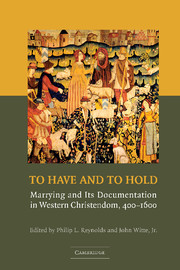Book contents
- Frontmatter
- Contents
- List of Contributors
- Preface and Acknowledgments
- List of Abbreviations
- 1 Marrying and Its Documentation in Pre-Modern Europe: Consent, Celebration, and Property
- 2 Marrying and Its Documentation in Later Roman Law
- 3 Marrying and the Tabulae Nuptiales in Roman North Africa from Tertullian to Augustine
- 4 Dotal Charters in the Frankish Tradition
- 5 Marriage and Diplomatics: Five Dower Charters from the Regions of Laon and Soissons, 1163–1181
- 6 Marriage Agreements from Twelfth-Century Southern France
- 7 Marriage Contracts in Medieval England
- 8 Marriage Contracts and the Church Courts of Fourteenth-Century England
- 9 Marrying and Marriage Litigation in Medieval Ireland
- 10 Marriage Contracts in Medieval Iceland
- 11 Contracting Marriage in Renaissance Florence
- 12 Marital Property Law as Socio-Cultural Text: The Case of Late-Medieval Douai
- 13 Marriage Contracts, Liturgies, and Properties in Reformation Geneva
- Index
10 - Marriage Contracts in Medieval Iceland
Published online by Cambridge University Press: 12 September 2009
- Frontmatter
- Contents
- List of Contributors
- Preface and Acknowledgments
- List of Abbreviations
- 1 Marrying and Its Documentation in Pre-Modern Europe: Consent, Celebration, and Property
- 2 Marrying and Its Documentation in Later Roman Law
- 3 Marrying and the Tabulae Nuptiales in Roman North Africa from Tertullian to Augustine
- 4 Dotal Charters in the Frankish Tradition
- 5 Marriage and Diplomatics: Five Dower Charters from the Regions of Laon and Soissons, 1163–1181
- 6 Marriage Agreements from Twelfth-Century Southern France
- 7 Marriage Contracts in Medieval England
- 8 Marriage Contracts and the Church Courts of Fourteenth-Century England
- 9 Marrying and Marriage Litigation in Medieval Ireland
- 10 Marriage Contracts in Medieval Iceland
- 11 Contracting Marriage in Renaissance Florence
- 12 Marital Property Law as Socio-Cultural Text: The Case of Late-Medieval Douai
- 13 Marriage Contracts, Liturgies, and Properties in Reformation Geneva
- Index
Summary
The small population of medieval Iceland and its wealth of documents make it an ideal setting for a case study of marriage that sheds light on how family and gender relations changed over a long period. However, one should keep in mind the special characteristics of medieval Iceland. Although it was highly literate, Icelandic society remained decentralized: there were no towns, and the royal administrations in Norway and (after 1380) in Denmark were far away. Moreover, throughout the medieval period, Icelandic society was dependent on animal husbandry, and landed property was one of the main sources of power.
Chiefly because Icelanders documented all transfers of land, many Icelandic documents relating to property transactions are extant from the late Middle Ages. Among them are written marriage contracts, all of which are in Icelandic. Although these contracts are concerned primarily with the transfer of property (especially the husband's gift called the mundr or brideprice), one cannot understand them fully without appreciating the influence of canon law on the institution of Icelandic marriage during the twelfth and thirteenth centuries.
The oldest information about the making of marriage contracts in Iceland dates from the twelfth century. These early contracts, which were not written but oral, involved both economic and political agreements. The thirteenth and fourteenth centuries saw a change in the way in which a marriage was contracted.
- Type
- Chapter
- Information
- To Have and to HoldMarrying and its Documentation in Western Christendom, 400–1600, pp. 360 - 389Publisher: Cambridge University PressPrint publication year: 2007



